Perrins Bluff is a remote peak in the Cradle Mountain-Lake St Clair National Park in lutruwita/ Tasmania.
Tabatha Badger reflects on a journey to the mountain made by Florence Perrin in 1920. Perrins Bluff is a remote peak only visible from one tiny stretch of the Overland Track. In January 1920 Florence Perrin, her husband George, and friend Charlie Macfarlane were guided to the region by legendary bushman Paddy Hartnett. Florence embarked on annual walking trips with Paddy and was the first female, since colonisation, to summit several peaks including Mount Ossa, the highest in Tasmania. But it was their 14-day expedition in 1920 that made a mark in Lutruwita/Tasmania’s history.
It has been four years since my wonderfully chaotic research project on Florence Perrin (1884-1952) began. Finally, the book on this forgotten Tasmanian bushwalker, botanist, and photographer, is set for print in spring 2024. So, this is a pertinent moment to share an epic off-track walk that shaped the project – the 2020 centenary Perrins Bluff pilgrimage.
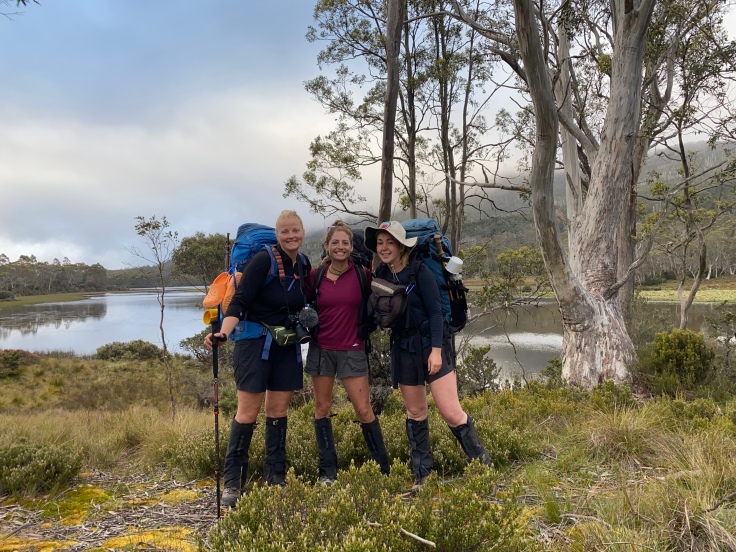
ABOVE: the team on the last day.
Perrins Bluff is a remote peak in the Cradle Mountain-Lake St Clair National Park, only visible from one tiny stretch of the Overland Track. It was January 1920 when Florence Perrin, her husband George, and friend Charlie Macfarlane were guided to the region by legendary bushman Paddy Hartnett. Florence embarked on annual walking trips with Paddy and was the first female, since colonisation, to summit several peaks including Mount Ossa, the highest in Tasmania. But it was their 14-day expedition in 1920 that made a mark in Lutruwita/Tasmania’s history, as the group summited the peak behind Ossa, then unambiguously called ‘Mountain #2’. Paddy determined to change the nomenclature to Perrins Bluff, in honour of Florence.
Come December 2020, it seemed surreal that after months of anticipation in various forms of isolation, we were finally following the vibrant blaze of red waratahs into the Tasmanian Wilderness World Heritage Area. Our mission was to summit Perrins Bluff to mark the centenary. With just days to spare in the year, we ditched initial plans to follow Florence’s precise 1920 route and took the most direct path. Our trio of female friends, Meahd, Lykke and myself, made a fitting composition on a trip for Florence, as she guided some of the first all-female botanic expeditions to Cradle Mountain.
Around Old Pelion Hut, where the 1920 Perrin cohort was based, we departed the track and entered the glorious scrub. We climbed onto a high plateau where the boggy ground held more leeches than water. In a tangle of ancient pencil pine, we pitched our tents. Under the guard of Mount Ossa, and with a view of Mount Oakleigh’s distinctive spires, we relished in the lost virtue of solitude and felt like the only people on the planet.
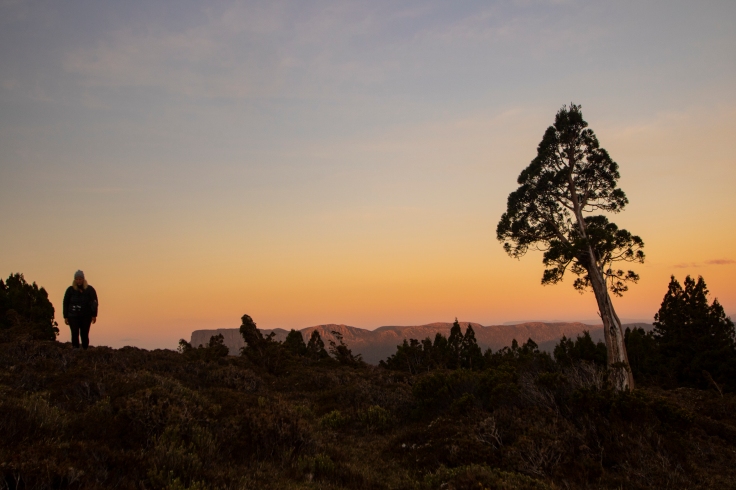
ABOVE: looking towards Mt Oakleigh
As the sun rose, Mt Oakleigh and Pelion East protruded proudly over the delicate white veil of mist floating through the valley below our campsite. Off in the distance, the familiar silhouettes of Barn Bluff and Cradle Mountain caught the first sun of the day. That was our que to head off, in order to beat the forecast heat. Our route over Mount Thetis would offer no shade, nor water. Heading up the dolerite massif, we skirted the southern slopes of a smaller, but no less characteristic peak, Paddy’s Nut. Why is it called Paddy’s Nut? Did Paddy think you were nuts if you wanted to climb this little boulder? Perhaps Paddy himself was nuts for persistently failing to summit Mount Ossa from this route (spoiler, he and Florence were finally successful in 1920 from roughly the present tracked way). This naming conundrum entertained us until we reached the saddle of the Nut and Thetis. Here things got challenging; Boulders the size of large busses had to be navigated with wieldy packs. Below each of the enormous dolerite stones was an inescapable abyss. Carefully we clambered, swore, and questioned our sanity. But we were also humbled by the thought of Florence navigating such terrain in a long skirt! She is celebrated as being one of the first in Tasmania to walk with button-up skirt and trousers underneath.
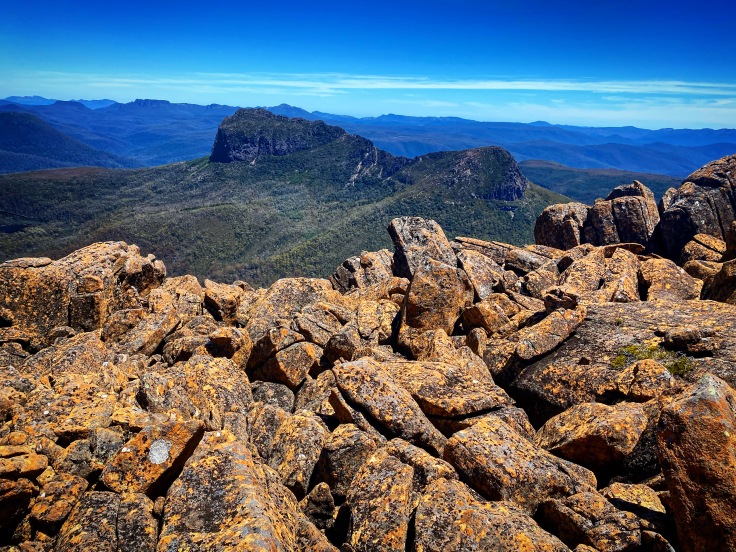
ABOVE: looking towards Perrins Bluff from Mt Thetis.
Atop Thetis at last, we caught a first glimpse of our elusive goal, Perrins Bluff. Under endless blue skies and uninterrupted Mountain views, we felt spoilt and thought of Florence’s quote from the day she had summited Perrins; “Oh, our west coast is a wild a rugged place. How I love it. The Mountains just put their arm around me and when I am away too long, they pull and pull, until I must go back.”
Tomorrow, we planned to be atop Perrin’s. But first, we had to get down the south-west side of Thetis. Sheer precipice greeted us. Shards of fine scree ran into more truck-sized boulders. There was one tiny scrubby crag, indeed this must be the ‘route’ down. The Abels, Tasmania’s Mountain bible, states that descending Thetis with full packs should be undertaken by “experienced walkers only”. Until this moment we had regarded ourselves as proficient in the bush, but this Mountain demanded a new level of respect.
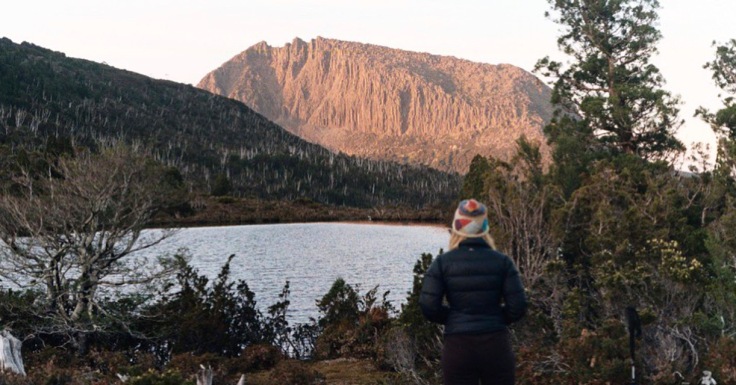
ABOVE: Tabatha looking towards Pelion West.
Once at the end of the delicate rock scramble, we were greeted by the task of penetrating a Nothofagus gunnii (otherwise known as tanglefoot) and King Billy forest. Down on all fours, we wriggled ourselves through only to arrive at the campsite and find we were no longer alone – thousands upon thousands of ants were everywhere, and suddenly through everything. Tired as we were, the tents went up quickly and the tea was boiled, restoring some sanity. The tarn by camp mirrored Pelion West glowing red on sunset. This marked bedtime for the ants who had suddenly all disappeared. A tangible feeling of immense gratitude overwhelmed us that evening – simply existing in the presence of these sublime and untamed Mountains filled our souls with appreciation for the likes of Florence, and those she walked with, who advocated for this entire region of splendour to be proclaimed a National Park. How lucky we were – Everything had seemingly fallen perfectly into place to summit Perrins the following day.
But the mountain weather had other plans.
5am I woke to bitter winds that swept horizontal rain through the camp, which was engulfed by heavy fog. The large tarn was scarcely visible from our tent pitched just metres away from the water. We sat, waiting, wearing every piece of clothing that we had to stay warm. This was our only day to make the summit, and I needed visual navigation clues to safely lead the others. As the weather persisted in the next few hours, we blamed the bad omen that was 2020 as a whole.
We had little choice but to surrender our centenary summit mission. Meahd gently reminded us of our place in this wild land; “the mountain allows you up to the top”. “And today she’s not allowing us” concurred Lykke. Our disappointment was slightly eased recalling the Perrin’s own 1920 woes. They retreated from summit attempts of Cradle Mountain, Barn Bluff, Pelion West, and Mount Ossa, before they finally achieved Perrins. They had 14 days, we had 4.
It felt like hours of walking through thick scrub, but we eventually, literally, stumbled onto a boardwalk section of the Overland Track. Approaching New Pelion Hut, the noise and bustle resembled peak season Everest Base Camp (so much for COVID isolation!). A Ranger was standing by. He took one glance at our sunburnt and leech-loved legs and shouted “Oh, you have NOT been on the Overland Track!”. A short amount of banter was shared before we hightailed it out of the hut metropolis, in search of tranquillity for our final night.
At Lake Ayr we made camp. An appropriate location – after the Perrins returned from their summit, Paddy discovered his horse, Ned, was missing from their Old Pelion Hut base. After a stroll he found the beast grazing by Lake Ayr.
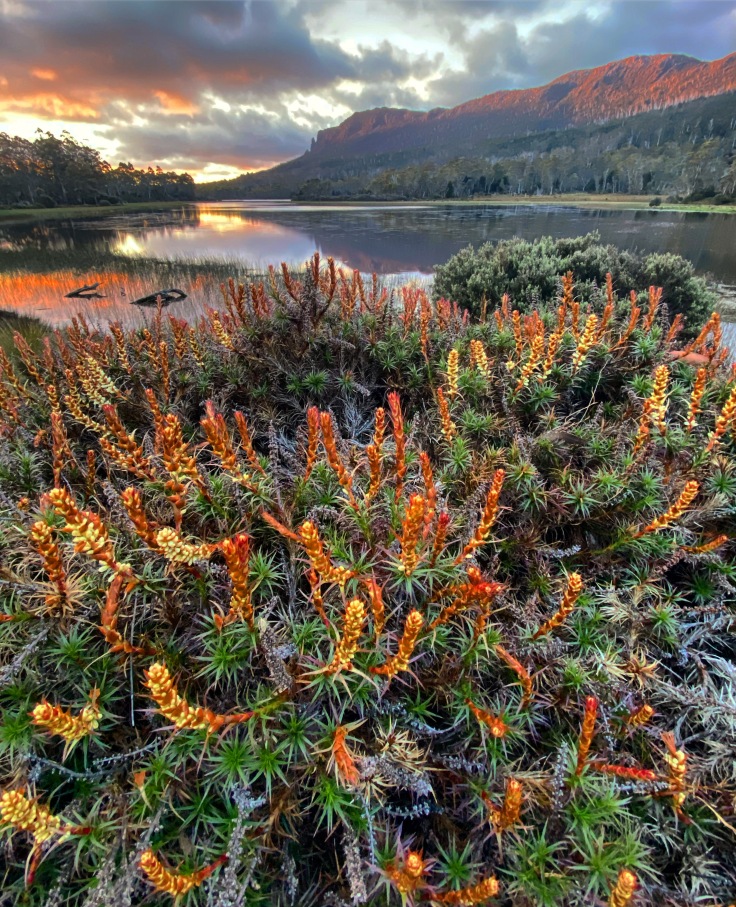
ABOVE: sunset at Lake Ayr
As the golden hour light ignited Mount Oakleigh a saturated orange, matching the flowering scoparia beside the Lake, we reflected on bushwalking, and how it has changed since Florence’s time. Unlike the Perrin cohort, we didn’t have a horse carrying 90 kilograms of canvas gear, nor could we light a fire for cooking and night-time warmth. Our comfort came in modern lightweight tents, specialty walking poles, down jackets and sleeping bags. Although, questionably, we may have carried the same weight in photography equipment as the Perrins did. While bushwalking adventure has significantly altered in appearance over the past hundred years, at its heart it has remained the same; it is the art of overcoming adversity in pursuit of a great goal and whether you achieve it or not, the memories made along the way are the greatest reward of all.
If you’re interested in the book Florence Perrin, keep an eye on https://tabathabadgerphotography.com, in mid-2024, for release details.












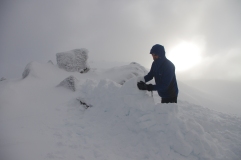













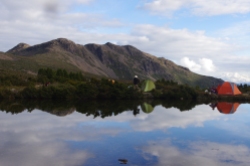


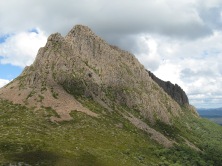






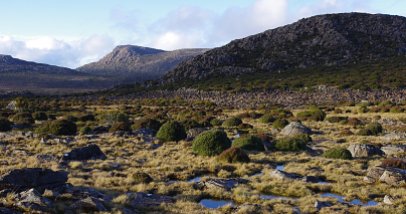



















Leave a comment